Agra is also known as the Land of palaces. Not just palaces, it also has a lot of intricate and beautiful architecture. Even the tombs are elaborately adorned. Agra is the perfect spot for a tourist and students of Architecture. Even the climate in Agra is very inviting and suitable. The city is well designed, where even the houses show huge detailing in their design. On close inspection, even the interiors of the buildings show the unreal imagination that the architects probably had. Every building, looks like it had been designed to adorn the city, designed artistically from every angle. Even the food speaks greatly about the spicy Indian Cuisine.
 |
| Agra Tourist Map |
Places to See in Agra
The heritage of the Mughal dynasty and their fascinating tombs, forts and mausoleums can be easily observed in and around the city of Agra. There are also other monuments and places that are famous for their beauty and significance in Agra.
Taj Mahal
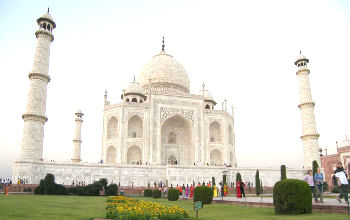 Category : History & Culture
Category : History & CultureThe Taj Mahal is one of the most famous tourist attractions in India and across the world. It's one of the Seven Wonders of the World. Completed in 1653, The Taj Mahal was built by Mughal Emperor Shah Jahan in memory of his beloved wife Mumtaz Mahal, as a symbol of eternal love. Taj Mahal is built on a red sandstone base, topped by a huge white marble terrace on which rests the dome flanked by four tapering minarets. The floors and walls have intriguing calligraphy and mosaic work adorned with precious stones. Timings: Open all days (except Friday and public holidays) from sunrise to sunset. Open at Night from 8:30 pm to 12:30 am on a Full moon night, two days before and after. More... |
Agra Fort
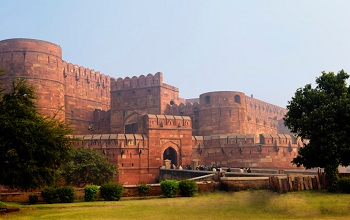 Category : History & Culture
Category : History & CultureAgra fort was commissioned by the great Mughal Emperor Akbar in 1565. During Shah Jahan's era, the red sandstone fort was reformed into a palace and extensively repaired with marble and pietra dura inlay. Distinguished buildings in the fort are the Pearl Mosque, Jahangir's Palace, Diwan-e-Am, Diwan-e-Khas (public and private audience halls), Shish Mahal, Musammam Burj and the Khas Mahal. The fort is semi-circular shaped, flattened on the east with a long, nearly straight wall facing the river. Timings: Open all days from 6:00 am to 5:30 pm. Entry Fee: Rs.300 for foreign tourist and Rs.20 for Indian tourist. More... |
Itmad-ud-Daulah's Tomb
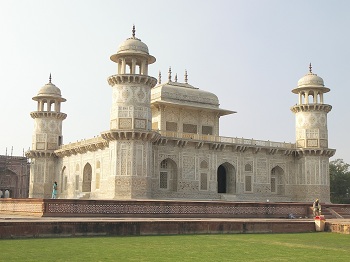 Category : History & Culture
Category : History & CultureThis Mughal Mausoleum in the city of Agra was built at the command of Noor Jahan (wife of Jahangir) for her father Mirza Ghiyas Bagh, who was honored with the title of Itmad-ud-Daula (pillar of the state). This is where the mausoleum took its name from. The walls of the mausoleum are built in white marble and embedded with semi precious stones. The cenotaphs of both the father and mother of Noor Jahan lay side by side in the tomb. Timings: Open all days from sunrise to sunset. Entry Fee: Rs.110 for foreign tourist and Rs.10 for Indian tourist. More... |
Fatehpur Sikri
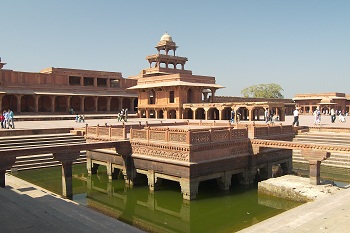 Category : History & Culture
Category : History & CultureFounded by the great Mughal emperor Akbar, in the year 1569, Fatehpur Sikri served as the capital of the Mughal Empire during the years 1571-1585. Named as Fateh (meaning victory) in the beginning, it was later known as Fatehpur Sikri. It was home for the birth of navaratnas (9 jewels). It stands as a representation of the infamous Mughal architecture with unique designs and artworks. The building was made of red stones and Akbar intended to revive the Persian court splendors made by his ancestor Timur, but eventually it came through as the classic Indian embellishments. The Fatehpur Sikkim was deserted after its completion due to natural calamities of insufficient water further triggered by the proximity of the Rajputana areas. The city is a piece of art that surrounds brilliant works by great minds of the strong Mughal period influenced by the emperors. Timings: Open all days from sunrise to sunset. Entry Fee: Rs.260 for foreign tourist and Rs.20 for Indian tourist. More... |
Akbar's Tomb
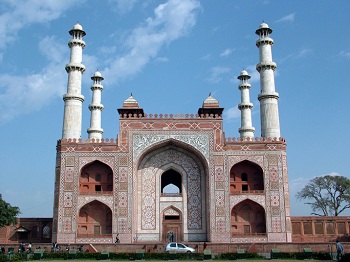 Category : History & Culture
Category : History & CultureBuilt solely for the great Mughal emperor, the Akbar Tomb was built in 1605-1613. It covers a good area of 119 acres in the Sikandra. It was Akbar himself who initiated the works in 1600 as per the Tartary tradition. Located in the suburbs, about a kilometer away lies the tomb of Miriam, Akbar's wife. The southern gate is similar to those of the Taj Mahal with 4 white marble chhatri and also serves as the entrance to the tomb. A wall of 105m square surrounds the tomb. The fake tomb is located in the marble pavilion placed inside a 4 tier pyramid building while the true tomb is safely kept in the basement. The building is made up of red sandstones with touches of white marble. One of India's greatest assets, the tomb is an attractive tourist spot, with people eager to see the tomb flooding the place. More... Timings: Open all days from sunrise to sunset. Entry Fee: Rs.110 for foreign tourist and Rs.10 for Indian tourist. |
Jama Masjid
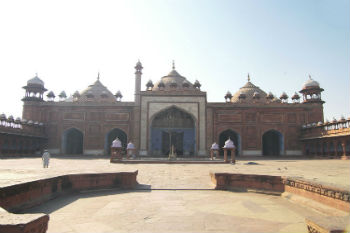 Category : Religious
Category : Religious Built in the 1648s, by Shah Jahan, Jama Masjid stands facing the Agra fort and overlooks the Agra Fort Railway Station in India. It was built by Shah Jahan in dedication to his favorite daughter. In order to create the Agra Fort Railway Station, the octagonal Tripolia Chowk was destroyed. The main entrance is on the eastern side. The prayer chamber is decorated with slender turrets with alternate kiosks. It is said to be the largest dome among the three and also the highest, crowning the sanctuary. The archway of the central portal has Persian inscriptions on white marble inland with black stones, in praise of Shah Jahan and Jahanara, his daughter. Made of red sandstone and marble, took 5,000 workers a period of 6 years to complete the magnificent building. It stands on a high plinth and has 5 arched entrances leading to the courtyard. More... |
Category : Religious
Among the holy places in Agra, Moti Masjid holds a special place. Proudly known as the pearl white, it was said to have been built by Shah Jahan for worship for the court members. Its artwork and beauty stamps the rich craftsmanship of India. Built between the years 1648 and 1654, it cost Rs. 1,60,000 to complete the works. It is made of 12 arches facing from the North, East and South. The main entrance is located on the eastern side, and the prayer chamber is ornamented with intricate designs adding glory to it. It is unique in its own way, with Hindu style kiosks which decorate the parapet. Consisting of 7 bays, it boasts of its white marble luxury. The Moti Masjid stands on grounds that slope from east to west. The sanctuary is sheltered by 3 bulbous sized domes. More...
Other Tourist Places in Agra
Besides these places, if time remains there are several other places in the city worth a visit. These include:
Sikandra Fort
Category : History & Culture
The last resting place of Akbar the great, 13 km away from the Agra Fort, the Sikandra fort is one of the preserved monuments in India. Started by Akbar, it was completed by Jahangir, his son which is the foundation for Sikandra Fort Complex. Surrounded by a beautiful lush garden, it is located in the western periphery of the city. The tomb reflects the characteristics of the great emperor with its beautiful and intricate carvings marking a phenomenal beginning to his end. The fort is built with precious red sandstone. Though provided with four gates it remains a mystery why only one (the southern gate) leads to the tomb. The nearest railway station and airport lie within 5kms and 13kms respectively. Looking at the great fort, it brings ancient Mughal history back to life right before your very eyes. More...
Bageshwarnath Temple
Category : Religious
Bageshwarnath temple is one of the most holy places in Agra, located at Ramratan Road in the North. It is the place of Baba Bageshwar. A temple of Lord Siva and a very old place of worship, it still remains unrecognized in comparison with other temples in Agra. During the festival period, however, it takes on the festival spirit and is covered in lights. Apart from being a holy place, it serves as a landmark for the area. It sees a huge crowd of devotees, all lined up throughout the year to get the blessings of Lord Siva. Easily accessible and connected tosolid well laid roads, it is one spot that just cannot be missed. The temple is located at a distance of only two kilometers from the heart of the city. It is a place worth spending time on. More...
Jodha Bai ka Rauza
Category : History & Culture
Akbar's favorite queen, Jodha Bai, built a palace of her own named after her as Jodha Bai ka Rauza. In comparison with other magnificent places built by Akbar, this was one of the most simple yet elegant piece of architecture. Jahangir who took Akbar's place after defeating him is the son of Akbar and Jodha Bai. She is said to represent the most architectural features of Gujarat and Rajasthan combining the Hindu and Muslim traditions, creating a delightful fusion. Jodha Bai is the daughter of King Bharmal of Amber and was among the three chief queens of Akbar. She was allowed to practice Hinduism and was also said to be involved in the political issues until Nur Jahan was crowned as the empress. Dedicated to this woman of great views and attitude, the Jodha Baika Rauza stands for her impact during the great emperor's rule. More...
Octagonal Tower
Category : History & Culture
Standing close to Shah Jahan's private hall is the octagonal tower also known as Musamman Burj. Built in the years 1631-1640 by Shah Jahan and dedicated to his wife Mumtaz Mahal, it is said to have replaced Akbar's small marble palace. It was built, such that the ladies could look outside, with delicate marble lattices engraved with ornamental niches. Built for the ladies, it has a fountain outside and a huge verandah surround the place. It was this place that Shah Jahan spent his last years as his own son's captive. It is also said to be the place where he spent time with his favorite daughter Jahanara Begum. Overlooking the Taj Mahal, it is situated in the Agra Fort. Beautiful and sad in its own way, it gives us a peek into Shah Jahan's final days on this earth. More...
Jahangir's Palace
Category : History & Culture
The most noteworthy building in the Agra Fort, Jahangir's Palace is the palace where the Rajut wives lived during Akbar's rule. It was a created as a fusion of Hindu and Central Asian architecture. The palace was a token of the great Mughal emperor, Akbar to his beloved son Jehangir, who later succeeded him to become the emperor. It has a huge bowl known as Hauzi Jahangir which is a master work of art carved from a single stone. It was used to hold the fragrant rose water. This palace was later used by the Mughal Queen Nur Jahan, who used it as her palace. Reflecting the culture, tradition and history of the civilians, this palace conquers it all when it comes to the way it was built with care and expertise. It holds great value for its elusive style. More...
Mehtab Bagh
Category : Garden
Mehtab Bagh translated to mean a moonlight garden, is located north of Taj Mahal and the opposite of the Yamuna River. A square garden measuring 300 m by 300 m, it becomes partially flooded by the rain duringrainy season. It was the last garden of the eleven built by the Mughals. It was built by the Mughal emperor Babur. Designed in the riverfront terrace pattern, it contributes a significant part to the Taj complex. The garden was said to be surrounded by a compound wall made of Brick, lime plaster and clad with red sandstone. Octagonal shaped domes were situated in the corners. A small Dalit shrine is present near the entrance. In a letter written to Shah Jahan by Aurangzeb, he mentioned the garden after a flood in 1652 AD. Archeological excavations were started in 1994 to renew the garden and give it a new flair. More...
Guru Ka Taal
Category : Religious
Located near Sikandra, the Guru Ka Taal is the Sikh pilgrimage dedicated to the 9th Sri Guru Tegh Bahudar Ji. It is the place where he laid down his arms to accept arrest in front of Aurangazeb. Dated back to the 17th century, the building was built in the year 1610. The reservoir was used to provide water during the dry season and was ornamented with precious stone carvings. The Gurudwara was built in 1970 due to the contributions of Saint Baba Sadh Singhji. When first built it had twelve towers, but only eight had managed to survive the years and remain intact. Constructed on red sandstones, it has the finest architecture notable by archeologists all over the world. It holds significance to many more such buildings and is a spot of tourist attraction. A number of devotees pay their respect every year to offer their prayers. More...
Soami Bagh Samadh
Category : Religious
On the outskirts of Agra, the Soami Bagh Samadh is situated, in Dayalbagh. Huzur Swami Maharaj (Shri Shiv Dayal Singh Seth) performed many poojas at this place. Hence, the Soami Bagh is of historic importance to the Samadh of Soamiji Maharaj. This place is the mausoleum of the Swamiji. In 1908, this Soami Bagh was constructed. The beautifully carved building has marble uniquely designed and cut to fit into each other and is of architectural beauty. The intricate designs on the marble blended perfectly are of historic interest and brings tourists to this place. The beauty of this creation has been compared to that of the Taj Mahal. The Bhajan Gar, located nearby performs Satsang everyday. The Bhandara festival celebrated here brings the Satsang together at this place. The Radhaswami Faith was established here and is of sacred interest in this faith.
Chini ka Rauza
Category : History & Culture
This is a monument in Agra which houses the tomb of Alamo Afzal Khan Mullsh. He was the Prime Minister during the reign of Shah Jahan, the famous Mughal Emperor. He was a renowned poet and scholar. In 1635, this tomb was built in his memory. The exquisitely built building has beautifully glazed tiles that are decorated well and has thus gained architectural beauty. The many inscriptions speak of the technical knowledge of the people in that era. The walls along with these inscriptions and colorful tiles give the building this name. Howeverthe building is mainly of brown stone and is rectangular in build. However, the central chamber is shaped octagonal with curved recesses that are eight in number. Square chambers that are eight in number are linked with the halls. The dome made in Afghan style is rounded and also has many important words from the books of Islam inscribed on it. More...
Mehran Bagh
Category : Garden
A Charbagh complex situated in Agra has become renowned, mostly due to the proximate location with the Taj Mahal. The Agra fort located opposite it has also grabbed the attention towards these places. Mehran Bagh is a perfect squared garden complex. It is designed such that it becomes partially flooded, especially during times of heavy rain. The complexity in construction sets a new standard for Mughal architecture. Mughal garden research also attained new heights with the dawn of this archaeological masterpiece. Mumtaz Mahals actual tomb has been actually found to be exactly midway between the entrance of the Taj Mahal complex and the ends of Mehran Bagh. The conclusion of the ASI survey led to the commencement of renovation and the restorative work of the garden. It is a site that is visited very frequently, especially by the botanists and by the nature lovers.
Radha Swami Samadhi
Category : History & Culture
This ancient tomb is situated about 15 km from Central Agra. It is a glorious building built with maximum utilization of white marbles. This building was built as the Samadhi ( tomb) of the founder of the sect Radha Swami. The founder was lovingly called as 'Swamiji Maharaj'. The Samadhi is adorned with intricate patterns and multifaceted designs on the inside. It is also known as Soamibagh. The construction work commenced many decades ago. However, the belief that the ardent followers hold is that the construction work should continue forever. It should never end. The aim of this continued construction is to make it a living monument. Hence the construction has gone on for 100 years. Despite the incomplete state, the ornate stone architecture has invited tourists from all over the world, to view Indian architecture in all its majesty.
Tourist Destinations Near Agra
Mathura
Situated at a distance of 58 km from Agra, Mathura is famous as the birthplace of Krishna. Now it is one of the major pilgrimage centers for the Hindus and has become a prominent spiritual tourist attraction in India. Shri Krishna Janam Bhumi, Vishram Ghat, Dwarkadheesh Temple, Gita Mandir are some of the places which find a connection to life of Krishna and are visited by their followers. More...
Delhi
The capital of India, Delhi is located at a distance of 216 km from Agra. If free, one can always pay a visit to one of the fastest growing cities of India. Delhi has a lot to offer to the tourists. The architectural wonders like Red Fort, India Gate and Qutb Minar, The places of religious significance like Akshardham Temple, Jama Masjid and Gurudwara Bangla Sahib, Sacred Heart Cathedral, plenty of malls for shopping purposes and lots more tourist attractions to explore. More...
Ram Bagh
The Rambagh Garden is popular as it has the distinction of being the very first garden of the Mughals that was built in India. The garden was built to entertain the Emperor's guests and also for the relaxation of the Emperor and his loyal people. This beautiful garden is famous for its unique style of design and attractive layout that depicts the love of the Mughal for natural beauty. More...
Last Updated on : December 05, 2025
Places to Visit in Agra
Places to visit in Uttar Pradesh
